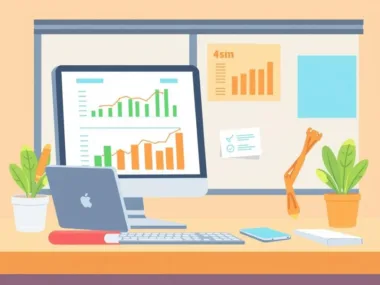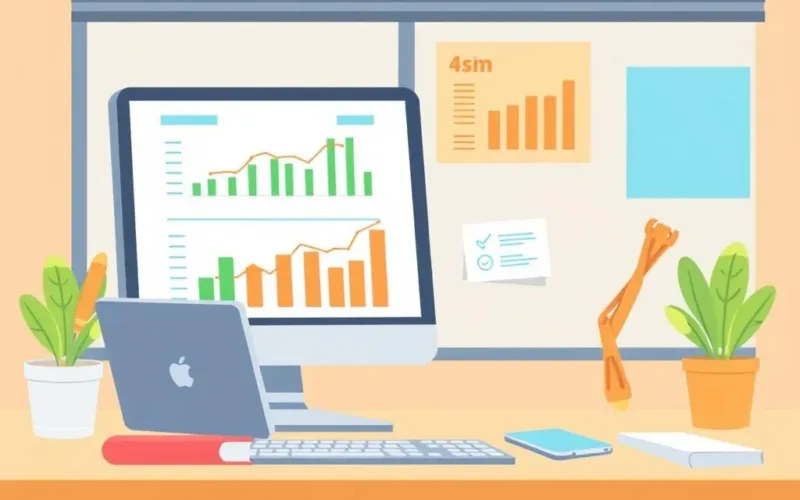Discover the best accounts receivable automation software and systems in 2025 with our comprehensive guide. Explore the benefits, key features, and top solutions like Bill.com, QuickBooks Online Advanced, and YayPay to streamline your AR processes, improve cash flow, and enhance customer relationships. Take your business’s financial management to the next level with automation technology.
Best Accounts Receivable Automation Software: A Comprehensive Guide
Accounts receivable automation uses software to automate these processes, leveraging technologies like artificial intelligence (AI), optical character recognition (OCR), and cloud computing to enhance efficiency and accuracy. Also, read the best accounts payable automation, accounts receivable vs accounts payable.
Introduction to Accounts Receivable Automation
Accounts receivable (AR) represent the money customers owe a business for goods or services delivered on credit. Managing AR involves tasks like creating invoices, tracking payments, and following up on overdue accounts—processes that can be time-consuming and prone to errors when done manually. What if there were a way to streamline these tasks, ensuring faster payments and fewer mistakes?
In 2025, AR automation has become a vital tool for businesses seeking to optimize cash flow, reduce administrative burdens, and improve customer relationships. From small startups to global enterprises, organizations are adopting these systems to stay competitive in a fast-paced financial landscape. This guide explores the essence of accounts receivable automation, its benefits, key features, top software solutions, and how to choose the right system for your business, all through a Socratic lens that invites you to reflect and discover.
What Is Accounts Receivable Automation?
Let’s consider a business that sends out invoices to dozens of clients each month. How might the accounts receivable team manage these invoices, perhaps by manually entering data, sending reminders, and reconciling payments? Could this process be slow or error-prone? Accounts receivable automation software automates these tasks, handling everything from invoice generation to payment collection and reporting. What might this mean for a business? Could it save time, reduce errors, or ensure more predictable cash flow?
AR automation systems typically include features like:
- Automated Invoicing: Generating and sending invoices based on sales or service agreements.
- Payment Processing: Offering online payment options, such as credit cards or ACH transfers.
- Collections Management: Sending automated reminders for overdue payments and escalating to collections if needed.
- Integration: Connecting with accounting software or enterprise resource planning (ERP) systems for seamless data flow.
- Reporting and Analytics: Providing insights into payment trends, aging reports, and cash flow forecasts.
How might these features address the challenges of manual AR processes? Can you think of a scenario where automation would make a significant difference?
Why AR Automation Matters
Why might a business prioritize automating its AR processes? If customers delay payments, what impact could this have on cash flow or operations? Could errors in invoicing lead to disputes or financial losses? Let’s explore the key benefits of AR automation:
- Improved Cash Flow: Faster invoice processing and payment collection reduce days sales outstanding (DSO), ensuring steady cash flow. A 2024 study by [Ardent Partners] found that businesses using AR automation reduced DSO by up to 30%.
- Reduced Errors: Automated data capture and validation minimize mistakes, such as incorrect billing amounts or duplicate invoices.
- Time Savings: Automation eliminates manual tasks, freeing up finance teams for strategic activities. The same study reported a 50% reduction in invoice processing time.
- Enhanced Customer Relationships: Timely, accurate, and professional invoicing improves the customer experience, fostering trust and loyalty.
- Compliance and Audit Readiness: Clear audit trails and standardized processes ensure adherence to financial regulations, such as GAAP or IFRS.
- Scalability: Automated systems handle growing transaction volumes, supporting business expansion without additional staff.
How might these benefits apply to a specific business you’re familiar with? Could they address pain points like late payments or administrative overload?
Key Features of AR Automation Software
What features might make an AR automation system effective? If you were designing such a system, what capabilities would you include to streamline the AR process? Here are some essential features to consider:
- Invoice Automation: Automatically generates and sends invoices using customizable templates, reducing manual data entry.
- Payment Processing: Supports multiple payment methods, including credit cards, ACH transfers, and digital wallets, with secure online portals.
- Collections Management: Sends automated payment reminders and escalates overdue accounts, improving collection rates.
- Integration: Connects with accounting software (e.g., QuickBooks, Xero), ERP systems, or CRM platforms for seamless data synchronization.
- Reporting and Analytics: Provides real-time dashboards and reports, such as aging reports, payment trends, and cash flow forecasts.
- Customer Portals: Offers self-service portals where customers can view invoices, make payments, and manage their accounts.
- Security and Compliance: Includes encryption, access controls, and audit trails to protect sensitive financial data and meet regulatory standards.
- AI and Machine Learning: Uses AI to predict payment behaviors, detect anomalies, or automate dispute resolution.
Which of these features seems most critical for a business’s AR process? Can you think of additional capabilities that might enhance efficiency or customer satisfaction?
Best Accounts Receivable Automation Software for 2025
Which AR automation solutions are considered the best in 2025, and what makes them stand out? The answer depends on your business’s size, industry, and specific needs. Below, we explore five leading accounts receivable automation software solutions, each excelling in different areas, based on industry trends and user feedback:
Bill.com
Best For: Small to medium-sized businesses
Rating: 4.6/5 (based on user reviews)
Key Features: Automated invoicing, payment processing, integration with accounting software, and customizable approval workflows.
Integrations: QuickBooks, Xero, NetSuite, Sage Intacct
Pricing: Starts at $39/month, with a free trial available
Overview: Bill.com is renowned for its user-friendly interface and seamless integration with popular accounting platforms. It automates invoice creation, payment tracking, and reconciliation, making it ideal for small to medium-sized businesses seeking simplicity and affordability. Its robust approval workflows ensure compliance with internal policies.
QuickBooks Online Advanced
Best For: Growing businesses
Rating: 4.7/5
Key Features: Robust reporting, automated invoicing, payment reminders, and scalability for complex AR needs.
Integrations: Intuit ecosystem, Salesforce, Shopify, PayPal
Pricing: Starts at $150/month, with a free trial available
Overview: QuickBooks Online Advanced offers comprehensive AR automation within the Intuit suite, including detailed reporting and integration with other business tools. Its scalability makes it suitable for growing businesses that need advanced features and robust analytics to manage increasing transaction volumes.
Xero
Best For: User-friendly AR management
Rating: 4.5/5
Key Features: Cloud-based invoicing, real-time bank reconciliation, automated payment reminders, and a strong ecosystem of add-ons.
Integrations: Stripe, PayPal, HubSpot, over 800 add-ons
Pricing: Starts at $37/month, with a 30-day free trial
Overview: Xero’s cloud-based platform provides real-time financial data and a user-friendly interface for AR management. Its extensive ecosystem of add-ons allows businesses to customize their AR processes, making it a versatile choice for small to medium-sized enterprises.
YayPay
Best For: AI-driven collections
Rating: 4.8/5
Key Features: AI-powered predictive analytics, automated dunning, customer portals, and advanced reporting.
Integrations: NetSuite, Sage Intacct, QuickBooks, Salesforce
Pricing: Available upon request, with a free demo
Overview: YayPay leverages AI to optimize collections, predicting payment behaviors and automating follow-ups. Its customer portals enhance the payment experience, making it ideal for businesses focused on reducing DSO and improving cash flow.
HighRadius
Best For: Enterprise-level AR automation
Rating: Highly regarded in industry reviews
Key Features: End-to-end order-to-cash automation, credit management, cash application, and dispute resolution.
Integrations: SAP, Oracle, NetSuite, Microsoft Dynamics
Pricing: Available upon request, with a free demo
Overview: HighRadius offers a comprehensive AR automation platform for enterprises, with advanced analytics and machine learning capabilities. Its focus on the entire order-to-cash cycle makes it a top choice for large organizations with complex financial operations.
Comparison Table
| Software | Key Features | Pricing (Starting) | Best For | User Rating |
|---|---|---|---|---|
| Bill.com | Robust reporting, automated invoicing, and scalability | $39/month | Small to medium businesses | 4.6/5 |
| QuickBooks Online Advanced | AI-driven collections, predictive analytics, and customer portals | $150/month | Growing businesses | 4.7/5 |
| Xero | Cloud-based invoicing, bank reconciliation, add-on ecosystem | $37/month | User-friendly AR management | 4.5/5 |
| YayPay | End-to-end order-to-cash, credit management, and advanced analytics | Request quote | AI-driven collections | 4.8/5 |
| HighRadius | End-to-end order-to-cash, credit management, advanced analytics | Request quote | Enterprise-level AR automation | High |
How do these tools align with your business’s needs? Which features seem most appealing, and why?
How to Choose the Right AR Automation Software
How can a business select the ideal AR automation software? The decision involves balancing your organization’s needs, budget, and operational goals. Let’s explore key factors to consider:
Assess Your Needs:
What specific AR challenges do you face? Are you struggling with manual invoicing, slow collections, or a lack of visibility into payment trends? Identifying these pain points will guide your feature requirements.
Consider Business Size:
Small businesses may prefer affordable, user-friendly tools like Melio, while enterprises might need robust solutions like HighRadius. How does your business size influence your choice?
Evaluate Integrations:
Does the software integrate with your existing accounting tools, CRM, or ERP systems? Seamless integration ensures data consistency and efficiency.
Check Scalability:
Will the solution accommodate your business as it grows, handling increased invoice volumes or additional users? Scalability is crucial for long-term success.
Review Usability:
A user-friendly interface reduces training time and encourages adoption. Can your team easily navigate the software, or will it require extensive onboarding?
Analyze Cost:
Evaluate the pricing structure to ensure it fits your budget, considering both initial costs and ongoing fees. Are there free trials or affordable plans available?
Prioritize Security:
How does the software protect sensitive financial data? Look for features like encryption, access controls, and compliance with standards like GDPR or PCI DSS.
Explore Support and Training:
Reliable customer support and training resources are essential for resolving issues and ensuring successful implementation. What level of support does the provider offer?
Read User Reviews:
What do other users say about the software’s performance? Platforms like [Capterra] or [G2] provide verified reviews to gauge real-world experiences.
Test with Demos or Trials:
Request demos or trials from providers like [Bill.com] or [Xero] to assess functionality and suitability.
Which of these factors seems most critical for your organization? Can you think of additional considerations that might influence your decision?
Implementing AR Automation: Best Practices
How can a business successfully implement AR automation? Let’s reflect on some best practices to ensure a smooth transition:
- Assess Current Processes: Review your existing AR workflows to identify inefficiencies and areas for improvement. What manual tasks could be automated?
- Engage Stakeholders: Involve finance teams, IT, and management to ensure buy-in and alignment with business goals. How can you address potential resistance to change?
- Choose Compatible Software: Select a solution that integrates with your accounting systems and meets your feature requirements. Why is integration critical for success?
- Provide Training: Train staff on the new tools and processes to ensure smooth adoption. How can effective training reduce implementation challenges?
- Test and Pilot: Start with a small pilot to test the software’s functionality and address any issues before full deployment. What benefits might a pilot offer?
- Monitor Performance: Track key metrics, such as DSO, invoice processing time, and error rates, to evaluate the software’s impact. How can ongoing monitoring drive continuous improvement?
- Update Processes: Regularly review and refine AR processes to align with changing business needs or software updates. Why is adaptability important?
What challenges might arise during implementation, and how could these best practices help overcome them?
Real-World Applications
Let’s consider how AR automation transforms businesses in practice:
- Small Retail Business: A boutique clothing store implemented [Melio] to automate invoicing and payment collection. By reducing manual data entry, the owner saved 10 hours per week, allowing more focus on customer service and inventory management.
- Mid-Sized Manufacturing Firm: A manufacturing company adopted [YayPay] to streamline collections. AI-driven payment predictions reduced DSO from 45 to 30 days, improving working capital by 20%.
- Large Enterprise: A multinational corporation used [HighRadius] to automate its order-to-cash process across multiple regions. The system’s advanced analytics identified payment trends, enabling proactive collections and reducing overdue accounts by 15%.
How might these examples apply to a business you’re familiar with? What specific improvements could AR automation bring to its financial operations?
Future Trends in AR Automation
What does the future hold for AR automation? As technology evolves, several trends are shaping its trajectory:
- Artificial Intelligence and Machine Learning: AI-driven features, such as predictive payment analytics and automated dispute resolution, are enhancing efficiency and accuracy. Solutions like YayPay and HighRadius are leading this trend.
- Cloud-Based Solutions: Cloud platforms enable remote access, scalability, and real-time data updates, supporting distributed teams and hybrid work models.
- Blockchain for Secure Transactions: Blockchain technology could improve payment security and transparency, particularly for international transactions.
- Mobile Accessibility: Mobile apps, like those offered by Xero, allow users to manage invoices and payments on the go, enhancing flexibility.
- Integration with Financial Ecosystems: AR automation tools are increasingly integrating with broader financial systems, such as accounts payable and treasury management, for holistic cash flow management.
- Sustainability: By reducing paper-based invoicing, AR automation aligns with eco-friendly business practices, contributing to corporate sustainability goals.
Which of these trends seems most exciting, and how might it impact your organization’s AR processes? Can you envision a scenario where these advancements create new opportunities?
Conclusion
Accounts receivable automation is a transformative technology that streamlines financial processes, enhances cash flow, and improves customer relationships. By exploring its definition, benefits, key features, and leading software options, you’ve gained a comprehensive understanding of its potential. Tools like Bill.com, QuickBooks Online Advanced, Xero, YayPay, and HighRadius offer diverse capabilities to meet various business needs, from small startups to global enterprises. As you consider implementing AR automation, reflect on your organization’s specific requirements, evaluate your options, and embrace the efficiency and strategic advantages that automation brings to your accounts receivable management. What steps will you take to explore AR automation further, and how might it transform your business’s financial future?












Leave a Reply